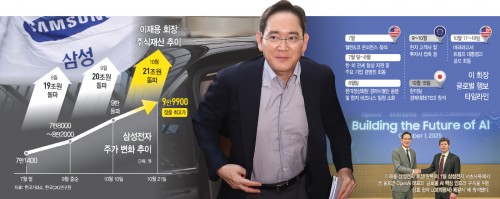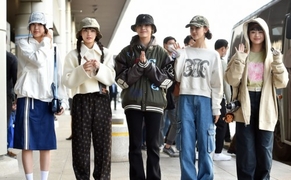 |
Over his three years as chairman, Samsung Electronics chief Lee Jae-yong has fought to both catch and lead the generative-AI wave. In a new era where outcomes are unpredictable, the share price of champion Samsung rode a roller coaster and earnings swung widely. One shackle was legal risk. Even as he met global leaders and partners to drive medium- to long-term strategy, prosecutors in Seocho repeatedly constrained his activity. The turning point came in July, when a court finalized his acquittal. M&A restarted, and a burst of overseas activity across the United States, Europe and Japan followed. Samsung reclaimed the memory-chip crown, and its foldable phones began tracing a clear upward curve.
Crucially, the company’s real strength in crisis may only now be coming into view. Partnerships with OpenAI, Broadcom and AMD are accelerating, with the “Stargate” project poised to be a key springboard for the AI era. At the center is Lee’s quiet but formidable leadership.
According to business circles on October 21, Samsung insiders attach little special meaning to the formal third anniversary of Lee’s chairmanship on the 27th, noting he has effectively overseen the group since 2014. “What matters more than an anniversary is results and securing growth engines,” one industry official said, adding that Lee’s “sajeuksaeng” (“die-to-live”) message from early this year still stands—so no big new message is expected. And on the 25th, it will be exactly 100 days since his acquittal was finalized.
Back on the global stage, with a different stride
Over the past three months, Lee’s schedule has been relentless. He attended the Allen & Company Sun Valley Conference in early July, networking with global media and tech chiefs, then visited Silicon Valley and Washington, D.C., for back-to-back meetings with Big Tech leaders. He also joined the business delegation for the Korea-U.S. summit, broadening his political-economic network, and later moved to Europe to meet semiconductor and IT clients and investors. In mid-October, he took part in the Trilateral Economic Dialogue (TED) in Japan and, in Florida’s Mar-a-Lago, joined other top Korean business leaders for a “golf meeting” with U.S. President Donald Trump. At month’s end, he is set to sit down with national leaders and global CEOs at the APEC CEO Summit.
During Lee’s August U.S. trip, Samsung reportedly signed a $16.5 billion foundry supply contract with Tesla. This month, it signed a letter of intent with OpenAI for strategic cooperation and began full-scale participation in next-generation AI data-center and infrastructure projects. Samsung Electronics, Samsung SDS, Samsung C&T and Samsung Heavy Industries will pool group-wide capabilities. Industry watchers say the collaboration ties into the $500 billion “Stargate” data-center build-out, a chance for Samsung to sharply raise its profile in the global AI infrastructure supply chain.
“Lee built a global people-to-people network as vice chairman and expanded it by accompanying top-level economic diplomacy,” said Hong Ki-yong, professor of business at Incheon National University. “That’s translating into influence over supply-chain reconfiguration and strategic partnerships—and, notably, into visible outcomes such as restored market trust, share-price gains and broader tech collaboration.”
From new businesses to social impact, resetting Samsung’s weight
An M&A clock frozen for roughly eight years is ticking again. In May, Samsung acquired the audio business of U.S. firm Masimo and Europe’s largest HVAC maker, FläktGroup. In July, it followed up by buying U.S. healthcare platform Zellus, diversifying its portfolio. The strategic board is now clearly set to secure future growth in vehicle electronics, AI and cleantech.
Social contribution is another pillar of Samsung’s leadership. Marking the fifth anniversary of the late Chairman Lee Kun-hee’s passing, the donated “Lee Kun-hee Collection” will embark on an overseas tour next month to major museums in the United States, the United Kingdom and Europe. More than 1 trillion won will be invested to support children with cancer and rare diseases and to strengthen infectious-disease response infrastructure. Lee is expected to travel to the U.S. next month to join the opening of the collection’s tour.
With the top leader fully back at the helm, experts say it’s time for Lee to lay out a direct blueprint for the future. “Having focused on restoring the global network and expanding the perimeter, the next step is a concrete technology strategy and new-growth roadmap,” Prof. Hong said. “That would provide a more predictable environment across industries while maximizing share and profitability in the AI supply-chain contest. If Lee broadens human and material exchanges through his network and drives strategic integration across affiliates, the competitiveness of the ‘Lee Jae-yong era’ will only strengthen.”
Most Read
-
1
-
2
-
3
-
4
-
5
-
6
-
7





















